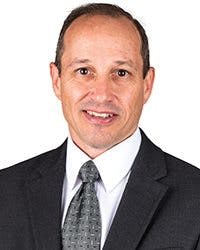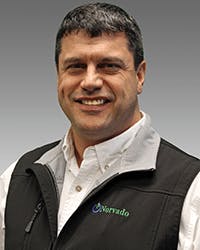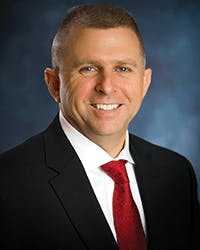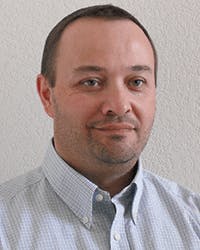Introducing Our 2018 ICT Visionaries
Thought Leadership You Can Use —
Today, everyone and everything is a brand — especially online. Some are credible. Others, not so much. That’s why it’s important for ISE magazine’s 2018 ICT Visionaries to share valuable insights that can help you succeed in this competitive industry.
Our 2018 group of Visionaries bring REAL experience to the table — the kind of experience you only get by putting in your due time. And with time and experience, you gain wisdom.
These 9 professionals have the chops to stand out amongst a crowd. They are innovative, knowledgeable, and have the results in their areas of expertise backing up their opinions. Enjoy reading their insights and perspectives in this first issue of the ICT Visionaries 2018 program.
Fiber and 5G
5G is now poised for launch worldwide. Clearly, 5G relies on fiber being extended deeper into the access network, and closer to the customer. Providers must deploy more small cells, home spots, and hot spots, in higher bands, with a coverage radium measured in meters versus kilometers.
Why is that not happening faster? What is needed for fiber densification, fiber to rural areas and fiber to meet the needs of 5G sooner than later?
Field Efficiencies
Though virtualization is intended to help create networks that allow providers to deliver the flexible, adaptable products their customers expect, field work still remains an important part of network upgrades today.
How can the industry help technicians and contractors do their job more efficiently and effectively? And why will the importance and expertise of the field tech not go away anytime soon?
IoT Progress
In 2018, there will be a significant push in IoT from operators as they roll out their LTE-based IoT solutions such as NB-IoT. This push should help stimulate the market, though it is still not growing quickly. Interestingly, forecasts say service providers could see only a 1%-2% revenue uplift from IoT.
Given that, is the juice worth the squeeze? Why or why not?
The Network Is the Threat
As custodians of the networks, carriers play a pivotal role in fighting new threats that are emerging. Customers will begin to expect, then demand, more proactive protection from the entire Internet value chain, and carriers will need to support these expectations with a range of technical and operational innovations.
Share your thoughts about this statement: The desire for greater security may be a boon for carriers, IF they embrace the need.
Streets in the Air
City streets may be choked with traffic, but the skies remain free. A recent survey by Ericsson showed 39% of those surveyed think their city needs a road network for drones and flying vehicles. But almost as many worry that a drone would drop on their head.
What are the telecom implications of drones, and what needs to be done to prepare for their future? What new demands will be placed on the wireline/wireless networks as a result of drone activity?
Join our ICT Visionaries at #ISEEXPO2018 at our Happy Hour Networking Event
Wednesday, August 15, 2018 5:30 – 6:30 PM
Colorado Convention Center, Denver, Colorado
Register Today!
Registration includes access to over 30 accredited seminars, influential keynotes, Live Demo Zone, exhibit hall with 200+ vendors and distributors, Happy Hour Networking Event, Vacation Giveaway and more.
Fiber and 5G
5G replaces the large radio towers of the past with smaller antennas that are placed literally in sight of one another. Data from these antennas is "forward-hauled" to a central point. A major requirement of the network is the need for extremely low latency. Thus, fiber is the logical choice.
This addition of many more network elements presents greater opportunity for expanded services as well as a more complex deployment challenge. The elimination of large towers will appeal to municipalities, but it is replaced by the need to deploy in many more places. By partnering with public entities, service providers may uncover ways to expedite deployments such as placing antennas on a light pole concurrent with a city is upgrading to more efficient LED lights.
IoT Progress
Simply put, the IoT allows you to accomplish things that you never could before. Consider the example of a trucking business that can now track the precise location of every one of its assets where in the past they only knew that a given truck was "somewhere between Tulsa and Dallas." The processing of this massive amount of information is impossible without computers, and the network that ties all of the pieces together.
Efficiencies have been gained, and further expectations have been set, meaning that rather than considering whether we should look for "juice," we more appropriately have to recognize that "the IoT genie is out of the bottle" and we must prepare the network to accommodate the opportunity.
Streets in the Air
One need to look no further than Verizon’s acquisition of Skyward to begin to imagine the possibilities of combining the utility of drones with the power of a world-class network. Drones are a new source of a large amount of high-quality data for enterprises, while service providers have at the core of their expertise the ability to collect, store and process such information. One might think of the combination of drones and networks as the "IoT on steroids."
Of course, the usefulness of drones in performing certain network operations cannot be overlooked. These aerial devices are already contributing to chores such as monitoring the maintenance needs of remote assets. The technology also holds promise for performing and managing asset inventory. Indeed, drones will have impact on our network in many ways.
[toggle title=”Biography and Company Profile” load=”hide”]Mike is responsible for directing all technology efforts at Amphenol Broadband Solutions, bringing together the creative forces of Times Fiber, Holland Electronics, Extreme Broadband Engineering, and All Systems Broadband. Mike has over 25 years of telecommunication experience with an outside plant focus; the first 20 years of experience began at Raychem. Previous roles include product development, product management, and sales.
Email: [email protected]
LinkedIn: /michaelgrice
Provisioning and AssuranceAT&T
Field Efficiencies
Field technicians are going to continue to be a critical resource for carriers. Virtualization provides greater benefits, but the physical layer is an important component — both wired and mobile. Tools for testing and isolation will continue to evolve to better isolate troubles. The expertise technicians provide from a real-world standpoint is invaluable and will continue to be a differentiator in providing industry leading service.
The Network Is the Threat
As the cybersecurity landscape continues to change, the move to software-defined networks builds network security controls into the infrastructure itself. With SDN, carriers can automate the filtering and scrubbing of some types of attack activity so that their customers no longer have to deploy or manage network security infrastructure while still retaining control of security policies. This should help simplify many facets of security for customers.
IoT Progress
The mobile revolution has transformed the way we do just about everything — creating endless possibilities in nearly every industry, including telecom, vehicle solutions, and even healthcare. At AT&T, we’re deploying LTE-M network technology that will reach new places and connect new things at a price that’s more affordable than ever before. By remaining committed in IoT, carriers are not only a part of this evolution, but will ultimately reduce costs, automate operations, and save time.
[toggle title=”Biography and Company Profile” load=”hide”]Natasha Clark began her career with AT&T in 2009. With a customer-centric approach, Clark oversees the Provisioning and Maintenance of the Local Network Services (LNS) Network, along with Low and High Speed Service Delivery (DS0, DS1, DS3) and Maintenance. Natasha earned a Master of Business Administration (MBA) degree and Bachelor of Science degree in Mechanical Engineering from the University of Missouri Kansas City. Natasha lives in Frisco, Texas, with her husband Anthony and their 2 daughters. Natasha can be reached via email at [email protected].
InvisiLight® Solution for Deploying Fiber
April 2, 2022Go to Market Faster. Speed up Network Deployment
April 2, 2022Episode 10: Fiber Optic Closure Specs Explained…
April 1, 2022Food for Thought from Our 2022 ICT Visionaries
April 1, 2022Fiber and 5G
There’s a debate in my house about Star Wars versus Star Trek.
When we watched Star Wars this holiday season, we debated whether teleporting (Star Trek) or the Force (Star Wars) was cooler. With Star Trek, beaming down to the new planet was for the entire population, while transporting one’s image to fight the First Order was obtainable by only the most powerful of the Jedi (Luke Skywalker).
My husband, a true Trekkie (he named his son after Patrick Stewart) votes for empowering the masses. My son, the body builder, says ultimate power should go only to those who work the hardest.
Such is the case with 5G. 5G will first focus on access for the masses. The standards bodies ratified a first 5G release for fixed wireless in December of 2017. This allows the 5G network buildout to start with the more simple case of fixed wireless access. The more complex, software-rich 5G mobile network functionality will follow by 2020.
5G channel blocks will be at 2,700 Mhz (or more), as compared to only 5 Mhz wide channels of 4G. That translates up to 1,000 times more bandwidth with gigabits of data similar to or even exceeding FTTH rates. Further, these networks will be denser with shorter range, further amplifying the need for fiber to carry this increased data throughout to more fiber-fed antenna locations.
The result: no need to debate Star Trek versus Star Wars — it’s both!
Streets in the Air
Drones may not be the final frontier — but they certainly are a new one. While there’s always concerns and challenges, the sky is the limit. No doubt, there are concerns about drones crashing and other concerns about the quality of service requirements needed to prevent such occurrences. But conversely, I’m excited about the safety elements that drones promise. Current estimates are that more than 30% of the cell tower climbs could be eliminated by the use of a Drone.
Field Efficiencies
Manufacturers need to design product to be craft-friendly. At Clearfield, more than lab-engineered, we require that our products are field-engineered as well as field-tested. This ensures the need of the contractor and technician are forefront in the design. As a result, the most significant cost of deployment, labor, can be reduced by streamlining the installation and maintenance function.
[toggle title=”Biography and Company Profile” load=”hide”]A founding member of Clearfield, Inc., Cheri Beranek is considered a communications visionary. She was appointed Clearfield President and CEO in 2007 after having served as President of APA Enterprises’ subsidiary APA Cables & Networks. Under her direction, Clearfield has recorded 10 consecutive years of profitability and posted historic gains in both the market capitalization and shareholder equity. Under her leadership, Clearfield was named to the prestigious Forbes Annual List of America’s Best Small Companies in both 2013 and 2014.
Fiber and 5G
We are very excited about 5G. In our view, several things need to happen. First, carriers need to better understand incremental revenue opportunities that a 5G infrastructure might deliver in order to pay for the investment. New business models that may include IoT and Smart City applications are enabled by higher antenna density, lower latency, and higher bandwidth, but these models will need time to prove out. Second, dense wireless networks require placement of more wireless access points into the network in places carriers have not typically deployed. It will take time for municipalities to come to terms on the rules and regulations that govern new locations such as street lamps, signage, or other fixed locations. Lastly, we look at the technology. The 3GPP NR standard was just released late last year. As operators validate the performance of this new technology, it will help them to better assess factors such as placement density, network performance standards, and customer adoption rates.
Field Efficiencies
As a world leader in optical solutions, we understand that the hard work of building the network cannot be displaced through virtualization. Digging trenches, placing cables, and installing network components is labor intensive work that will continue to require a formidable workforce into the foreseeable future. Our understanding suggests that labor and civil works can easily be more than 50 percent of the total deployment cost. The quality of the network is largely dependent on the skills and qualifications of the installer. At Corning, we work hard to innovate solutions that enable efficiencies to maximize installation workforce. Examples range from FastAccess® technology cable sheaths to preconnectorized solutions that eliminate costly and time-consuming splicing into the network or even software solutions that accelerate network survey and design steps.
IoT Progress
From a Corning perspective, we believe 5G densification is not a question of if but more a question of when. As the first operators deploy dense networks to deliver IoT, they will have a first-mover advantage against the competition when it comes to 5G. One thing that continues to prove itself time and time again is that consumers are willing to pay for faster-speed Internet connections. We believe that certain aspects of 5G will be demanded from consumers as soon as the technology proves what it can support.
[toggle title=”Biography and Company Profile” load=”hide”]Bob Whitman is responsible for global Carrier Networks Market Development to include strategy and execution of Corning’s Fiber-to-the-Home (FTTH), Fiber Deep, Inside Plant, and other Carrier network applications. Active for 15 years promoting optical fiber networks through education and public policy, Bob has developed commercial and technical expertise in all aspects of optical communications. He is one of the three founding individuals of the FTTH Council NA. Previously, Bob was Director for Global FTTH Program Management, and has held a variety of Engineering, Marketing ,and Market Development positions. Prior to joining Corning in 1997, Bob served as a Nuclear Power Engineering Officer in the US Navy.
Fiber and 5G
I believe in 5G even though there are several challenges associated with its deployment. Equipment costs for new product is very high today but will come down as the volume increases. Installation costs are going to be high due to the number of towers required. The last issue isn’t a technology problem but rather the supporting infrastructure. We learned as toddlers that square pegs don’t work in a round hole and we know square pizza boxes don’t fit on a round light pole. Right-of-way and old-school thinking from state and city governments is a barrier that must be overcome with updated zoning laws. The city governments need to understand the difference between a macro cell and a small cell, yet many are treating them as the same. Could we use the customer premise as the small cell location? They have power, and many have fiber already installed. This is a negotiation waiting to happen to bypass difficult right-of-way regulations.
IoT Progress
Operators are focused on the network yet we all should be focused on solutions. The cost of a data package for IoT devices is affordable. Many companies including ESPi, are investing in R&D for hardware and software. The real value begins when we get solution oriented. Many of the large carriers are helping with their own software/hardware kits that are easy to set up and very affordable. The availability of low cost and open-source hardware will spawn innovation from large tech companies all the way down to high school students. We aren’t even aware of all the devices that we will want "connected". Give it some innovation time.
Streets in the Air
The sky was the limit when brothers Orville and Wilbur took flight in 1903. It took until 1926 before the Air Commerce act was put into place. Finally, in 1958, Mike Monroney (a fellow Oklahoman) introduced a bill to create the independent FAA. There is no doubt that autonomous vehicles and drones will need designated paths in the air, yet accidents will still happen despite our best efforts. Low latency networks with accurate timing will be imperative to the success of drones.
[toggle title=”Biography and Company Profile” load=”hide”]Chris has more than 20 years of telecom engineering experience, and has a passion for powering things. He was instrumental with one of the very first IPTV-over-copper deployments in the US. He was also the 1st MEF CECP engineer in Oklahoma. He holds multiple patents and continues to create innovative ways to power network devices, including the award-winning Voltar solar UPS. He lives in Stillwater, Oklahoma, with his wife Paige and 2 Westies. Email: [email protected]
Fiber and 5G
The wireless providers will first focus on major cities. Until 5G is rolled out in major cities or cities where the wireless provider has high density fiber, we will not see it hit the rural market. In order to push wireless providers into rural markets, the cost to lay fiber will need to be significantly reduced or supplemented by some program to increase the ROI on a 5G deployment.
Field Efficiencies
We will never be able to virtualize hands on the ground. When a service is installed and not working due to low light levels, a remote server is not going to be able to troubleshoot and clean all of the passive elements between your Customer NID and PE router. The field tech provides us the ability to resolve that issue while also being the face of our company. One main value to virtualization is to help the tech with troubleshooting the service piece of an order through remote diagnostics.
Streets in the Air
Drones have been a huge help in reducing cost for site evaluations of wireless deployments. If a new road network was created for drones, I would think this would drive building a network infrastructure to track and maneuver the drones. As safety is a concern, this might drive building drone highways in rural parts of America to minimize risk. In theory, this could drive fiber expansion deeper into the network and could provide service to some tougher parts of the country.
[toggle title=”Biography and Company Profile” load=”hide”]Christopher Sigley creates network standards for ISP and OSP Engineering. He is currently based out of Allen, Texas. Previously, Christopher worked as Director of Video and Network Engineering. He graduated from Tulane University with a Bachelors of Science in Electrical Engineering.
Field Efficiencies
Mobile Apps have entered the workplace and are making a significant impact on efficiency currently. They have eliminated much of the paperwork and played a key role in reducing the total trouble ticket and service order times for Norvado. I expect more app functionality in the upcoming years that will make technicians more efficient by integrating time and expense tracking, give instant view of demark devices indicating network up/down status, and automatic resource assignment based on geo-location and assigned work load.
Three key trends will demand field technicians with ever increasing skill sets for many years to come. First, as the current 3 networks hauling voice, video, and data converge to one IP network it will lessen the need for separate wired networks and increase the need for higher level networking skill sets. Secondly, the importance of WIFI, along with the influx of devices in the home, requires RF wireless network design skills. Last, the technician needs to be able to evaluate needs and provide the customers with solutions in a sales consultant role.
The Network Is the Threat
Customers simply want the connectivity to their specific content to be there always and they don’t correlate that open Internet or net neutrality results in increased security risk. With net neutrality off the table nationally, carriers could offer a package that would better protect the consumer while prioritizing the content that the customer wants to access. Providing a service with higher security and customized connectivity for the individual will be an attractive offering. As consumers realize that they need protection more than they need uninhibited Internet access they will be ready to pay for the better protection safeguards.
Streets in the Air
Streaming video and real-time sensor reporting to the data center locations will add to the wireless network congestion. Video for interactions with the end customer may be the most important as police and medical uses expand first, and these communications will come with significant bandwidth requirements. Temperature, speed, location, and height to verify departure, travel location, arrival and delivery are going to be critical to track once laws allow unoccupied flight vehicles to range outside of sight, but they won’t demand much for bandwidth needs.
[toggle title=”Biography and Company Profile” load=”hide”]Rob Lombard is the Broadband Operations Manager at Norvado, located in Northwestern Wisconsin, where he has worked since 1998. He spent 7 years prior to that with Nortel in the transport, switching and cellular markets earning him 27 years in the telecommunications industry with extensive experience in network engineering and designing of wireline, wireless, cellular, IPTV and broadband networks. He can be reached at [email protected].
Field Efficiencies
As networks continue to evolve and new technologies, such as SDN, become a reality, the role of a field technician will also evolve. In addition, tomorrow’s networks must begin to have the intelligence to self-identify problem areas and improved diagnostics capability as well as in-network performance flexibility and new product opportunities. Together, this will aid technicians in targeting the physical work that is required in the field. It will also allow them to spend less time diagnosing the issue and more time fixing the specific issue causing the problem. While networks continue to become more intelligent, the role of a field technician will naturally become more sophisticated.
IoT Progress
IoT progress appears to be quickly gaining momentum. While IoT has been talked about for a number of years, the pace of new applications is now suddenly growing more rapidly. Moving forward, if the growth is significant, it will manifest in additional demand for bandwidth capacity. To prepare, carrier networks must remain ahead of the demand curve. While the type of traffic is not new, the volume could be substantial. Waiting until it arrives is simply not an option as it will only put more stress on networks and lead to more customer frustration. The challenge (or opportunity) is to stay one step ahead of customer demand.
The Network Is the Threat
Network threats are an ongoing part of the daily management of a network. The form of the threat is ever-changing, therefore, carriers must continue to evolve to meet customers’ expectations. Carriers have a responsibility to remain ahead of emerging threats in order to ensure they do not impact the overall performance of the network. Customers expect a solid, reliable network. By proactively addressing security issues, carriers can keep the network running clean for customers. In addition to network security, we strive to educate our customers on measures they can take to protect their home networks. Together, we can all work to minimize the impact of security threats.
[toggle title=”Biography and Company Profile” load=”hide”]Andrew joined TDS Telecom in 1989. Today, he has responsibility for the entire Field Services team. Under his leadership, this team provides timely service installations for consumer and commercial customers. This team also conducts routine preventative maintenance, including testing the integrity of the inside and outside plant networks to ensure ongoing availability of Internet, video and voice services. This team is also responsible for repairing outages caused by natural disaster, equipment failure, or damaged network facilities.
Fiber and 5G
The primary limiting factor in fiber densification remains economics. Carriers are heavily incented to bring fiber closer to customers. However, build costs are substantial and business cases require equally substantial revenue. Cost improvement is difficult, as labor heavily anchors deployment costs.
Opportunities exist and carriers continue to pursue and execute tactical fiber expansion. While 5G may improve fiber densification economics in urban environments, rural challenges are likely to remain. With low customer density still inhibiting 4G deployment in many rural markets, reducing the coverage area from kilometers to meters seems to offer only pockets of opportunity.
Field Efficiencies
Talented and effective field resources will continue to be critical to deploying and maintaining a dependable network. Expediting the evolution away from legacy network architectures could greatly improve the efficiency and effectiveness of these field workforces.
Legacy networks are complex structures with a large variety of unique and specialized devices. At scale, this environment produces technology silos and localized pockets of expertise. This creates training and flexibility challenges for field technician and contractor staff.
Embracing generic hardware and virtualization could dramatically reduce field complexity. Significant complexity will remain, as will the need for a field workforce with technical expertise. However, the reduction in hardware variance and uniqueness should greatly simplify training and increase workforce flexibility.
The Network Is the Threat
Until a fundamental improvement occurs in the security of end user devices, security will continue to be a challenging opportunity for carriers. As threats expand, customers will increasingly gravitate to carriers able to effectively protect their own infrastructure, and to those that offer creative and effective security services.
Strategies for larger issues, like DDoS mitigation, would benefit from a more cooperative approach within the industry. While attack vectors are worldwide and cross carrier infrastructure boundaries, monitoring and mitigation is fragmented and generally localized within individual carrier networks. A holistic solution could be significantly more effective than the status quo.
[toggle title=”Biography and Company Profile” load=”hide”]Jeff is responsible for the standards and integrity of the Windstream transport network. His organization is responsible for establishing the engineering equipment standards and roadmap, the provisioning of layer 1 and 2 infrastructure, and ensuring the continuing reliability and integrity of the Windstream transport network. Jeff has over 20 years of telecommunications experience, both ILEC and CLEC, predominantly focused on architecture, test and certification, planning and engineering. Jeff can be contacted via email at [email protected].
Sources
5G’s Wireline Pulse Beats for Fiber, by Dan Littman, ISE magazine, November, 2017. https://isemag.com/2017/11/5gs-wireline-pulse-beats-for-fiber/. The article is an excerpt from the report Communications Infrastructure Upgrade: The Need for Deep Fiber, by Deloitte.
Ericsson ConsumerLab’s seventh edition of its annual trend report, The 10 Hot Consumer Trends for 2018 and Beyond, December, 2017. See also: Ten hot consumer trends for this year and beyond, by The Nation, January 8, 2018
Technology, Media and Telecommunications Predictions 2018, by Delotte. https://www2.deloitte.com/cn/en/pages/technology-media-and-telecommunications/articles/tmt-predictions-2018.html





















